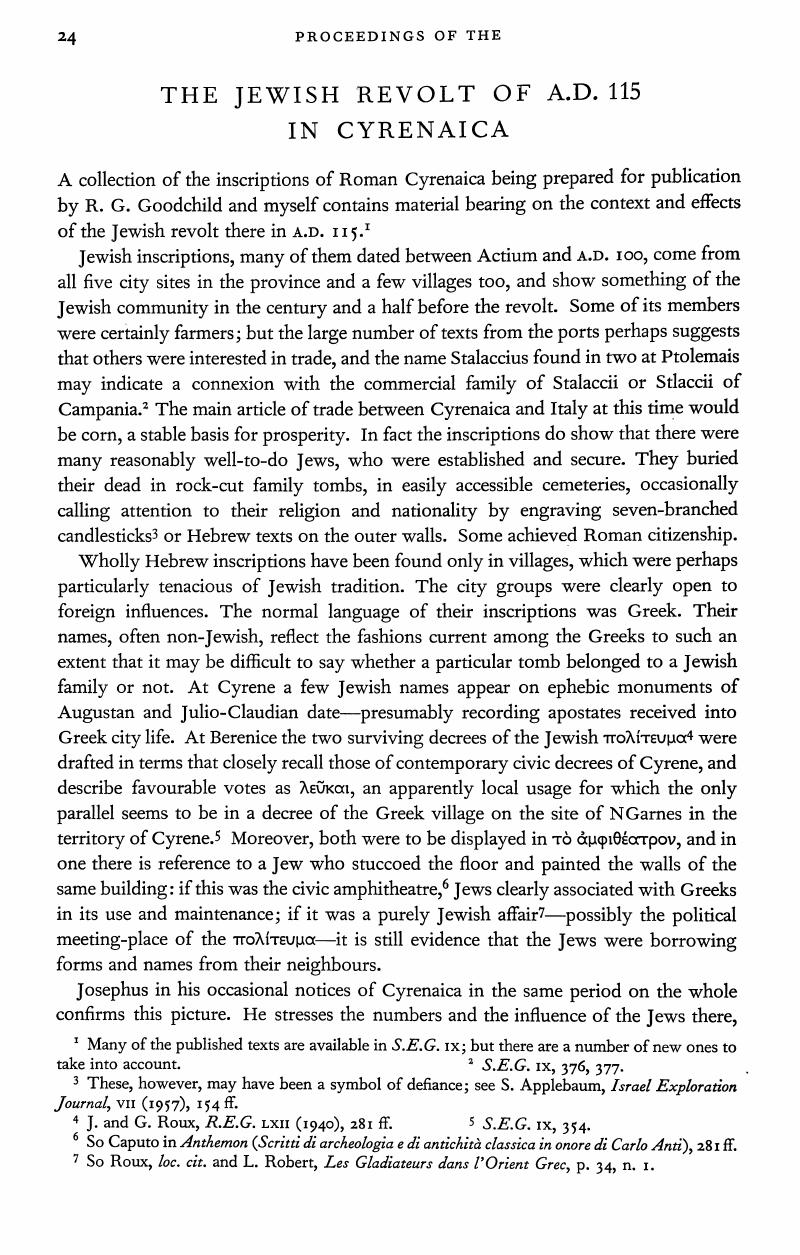No CrossRef data available.
Published online by Cambridge University Press: 09 November 2018

page 24 note 1 Many of the published texts are available in S.E.G. IX; but there are a number of new ones to take into account.
page 24 note 2 S.E.G. IX, 376, 377.
page 24 note 3 These, however, may have been a symbol of defiance; see Applebaum, S., Israel Exploration Journal, VII (1957), 154 ff.Google Scholar
page 24 note 4 J., and Roux, G., R.E.G. LXII (1940), 281 ff.Google Scholar
page 24 note 5 S.E.G. IX, 354.
page 24 note 6 So Caputo in Anthemon (Scritti di archeologia e di antichità classica in onore di Carlo Anti), 281 ff.
page 24 note 7 So Roux, loc. cit. and Robert, L., Les Gladiateurs dans l'Orient Grec, p. 34, n. 1Google Scholar.
page 25 note 1 Ant. Iud. XVI, 160 ff.Google Scholar
page 25 note 2 Bell. Iud. VII, 437 ff.Google Scholar; Vita, 424 ff.
page 25 note 3 In Studies in Roman Economic and Social History in honour of A. C. Johnson, pp. 23 f.
page 25 note 4 Zion, XIX (1954), 23 ff.Google Scholar, in Hebrew; Dr J. L. Teicher very kindly translated the article to me, but I must admit the strong probability that, from lapses of memory, I have not done justice to Applebaum's argument.
page 25 note 5 Tac, . Ann. XIV, 18 Google Scholar.
page 25 note 6 For example S.E.G. IX, 165, 166, 360.
page 25 note 7 Grom. Vet. 1, p. 122 LGoogle Scholar.
page 25 note 8 N.H. XIX, 39 ff.
page 26 note 1 See p. 25, n. 2; Josephus is not a disinterested witness, since he was himself implicated.
page 26 note 2 See, for example, the evidence collected by Applebaum, , J.R.S. XL (1950), 87 ff.Google Scholar
page 26 note 3 Collected by Fuks, A., Aegyptus, XXX (1953), 131 ff.Google Scholar
page 26 note 4 Preisigke, , Sammelbuch, I, 1742 Google Scholar.
page 26 note 5 See, for example, Romanelli, P., La Cirenaica Romana, pp. 109 ff.Google Scholar
page 26 note 6 LXVIII, 32, 1–2.
page 26 note 7 J.R.S. XL (1950), 84 Google Scholar, n. 37 and Orosius, VII, 12b.
page 26 note 8 Dated, unfortunately, only by the letter forms; it is perhaps also relevant that among these are several that employ formulae common on tombs from Asia Minor, but not certainly attested at an earlier date in Cyrenaica—they may be the product of the immigrant tradition.
page 27 note 1 Fraser, P. M., J.R.S. XL (1950), 77 ff.Google Scholar
page 27 note 2 Smith, R. M. and Porcher, E. A., History of the Recent Discoveries at Cyrene, p. 112, no. 10Google Scholar.
page 27 note 3 S.E.G. IX, 252; Reynolds, J. M., P.B.S.R. XXVI (1958), 161 ff.Google Scholar; A.E. 1928, no. 2.
page 27 note 4 S.E.G. IX, 136.
page 28 note 1 A.E. 1946, no. 177; Pernier, L., Nuova Antologia, ser. 7, CCLVII (Genn.–Febb. 1928), 222 Google Scholar.
page 28 note 2 For example Reynolds, loc. cit. p. 164.
page 28 note 3 Social and Economic History of the Roman Empire (2nd edition), pp. 310 f.
page 28 note 4 La Cirenaica Romana, pp. 123 and 153.